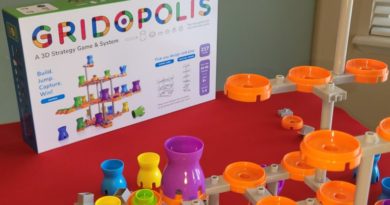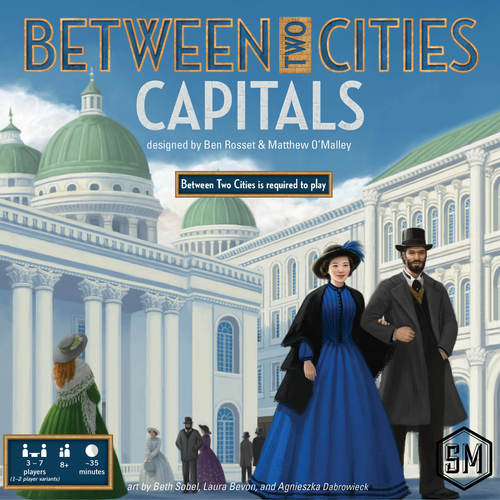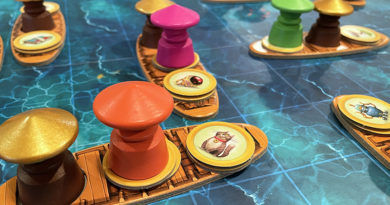King of Tokyo: Dark Edition game review

In 2012 we reviewed one of the hot new board games that year, King of Tokyo.
King of Tokyo is a push-your-luck board game where you get to play “king of the hill” using dice, special ability power cards, and cool monsters.
It’s no wonder why it jumped to “hot game” status because it’s easy to play and a lot of fun for up to 6 players.
iello quickly published an expansion for the game, King of Tokyo: Power Up. And a couple of year later released King of New York.
Last year, they published a collector’s edition of the game called King of Tokyo: Dark Edition and we’re excited to share our thoughts about it.
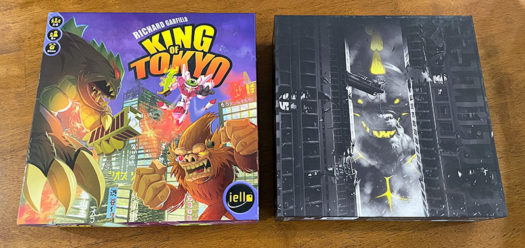
How to play King of Tokyo: Dark Edition – What’s New
King of Tokyo: Dark Edition plays almost exactly the same as the original King of Tokyo. Players try to be the last monster standing or to be the first to get to 20 victory points. They do it by rolling dice and using power cards to wound the other monsters and gain points.
If you’d like to get more details than that on the overall game play, check out our original video review of the game.
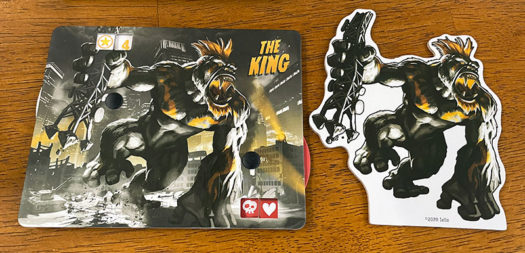
The part that isn’t the same is a sweet new addition of Wickedness points, tiles, and powers.
That’s right, now players can gain a few more powers by increasing their “wickedness” level!
In the game, when players roll 3 of a number on the dice, they get that many victory points. For example, if they roll 3 3’s, they will earn 3 points. If they roll 3 1’s, they’ll get 1 point.
In most games we play (and we’d guess this is similar with other groups), players aren’t really tempted to hold on to the 1’s and 2’s that they roll. That’s because it uses 3 dice to just get 1 or 2 points.
In the new Dark Edition, there’s value in holding on to those 1’s and 2’s because that’s how players gain Wickedness points!
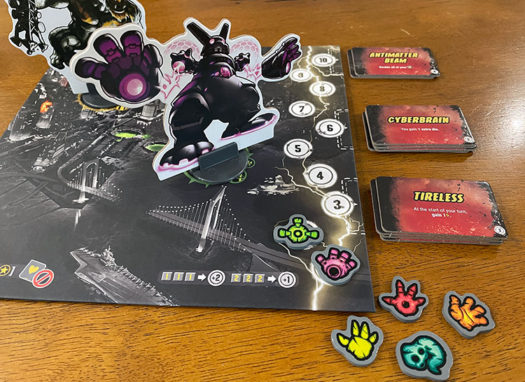
When a player has 3 1’s, in addition to getting 1 victory point, they also gain 2 wickedness points. And when they have 3 2’s, in addition to getting 2 victory points, they also gain 1 wickedness point.
When a player gains wickedness points, they move their corresponding monster wickedness counter up the track on the side of the Tokyo board. When a player’s counter reaches 3 points, they get to choose one of that level’s wickedness tiles. They keep that tile in front of them and use its power for the rest of the game.
As they hit the 6 and 10 point marks, they likewise get to choose a tile from those levels.
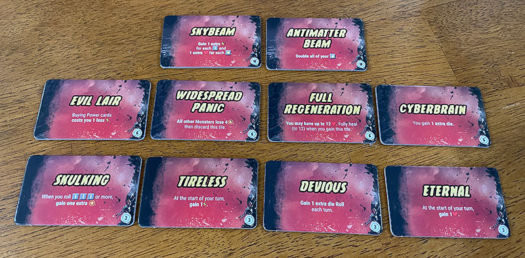
The Wickedness tiles are double-sided and at the outset of a game, players can choose if they’d like to play with either the red or green sides (or a mix).
We really like this addition to King of Tokyo because it makes the choices of which dice to keep a bit more interesting. Instead of just casting aside the 1’s and 2’s, we’re now seeing them as more useful as they can grant extra abilities during play.
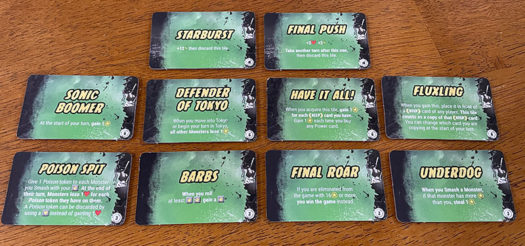
Non-Gameplay Differences
The rest of the changes to the game are all in the components.
As you can easily see, there are some dramatic changes in the visuals with King of Tokyo: Dark Edition.
The black & white style of all the components (with a slight splash of color here and there) creates a more ominous theme. Whereas the original artwork was colorfully cartoony, the Dark Edition feel more somber. But because the game play still revolves around the luck of the dice rolls, the illustrative nature in the artwork is still fun too.
But you can see that all for yourself simply by checking out these few photos of the artistic differences in the board and cards.
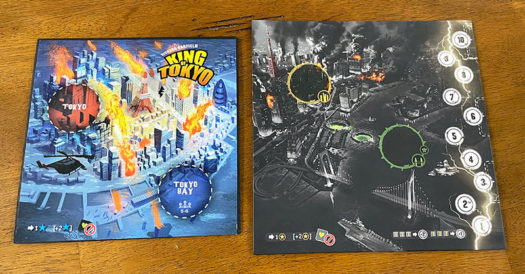
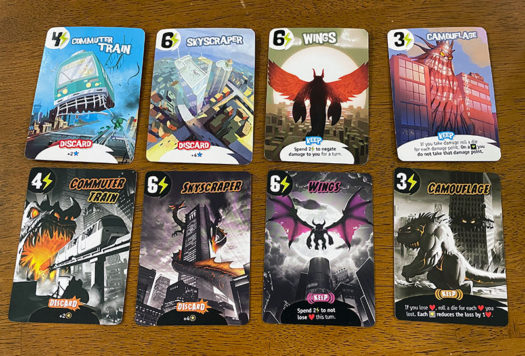
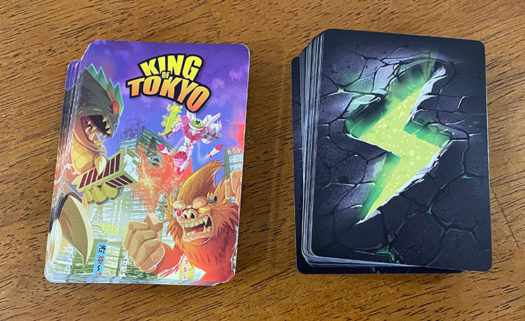
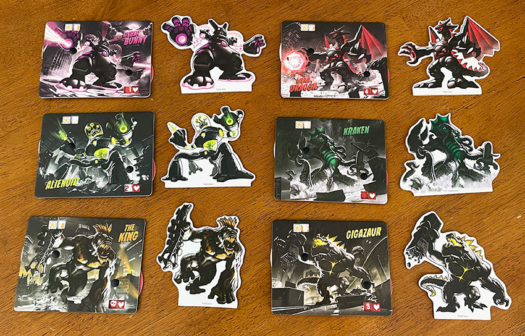
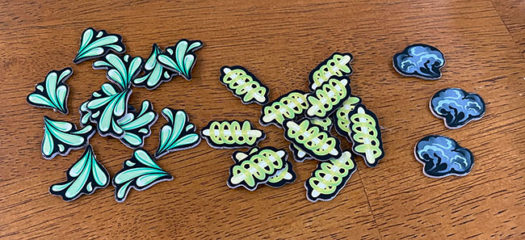
Most of the Power cards in the game have the same name and abilities as the original game. However, there are a number of new cards in the mix with the Dark Edition. Check out this photo showing a handful of new cards.
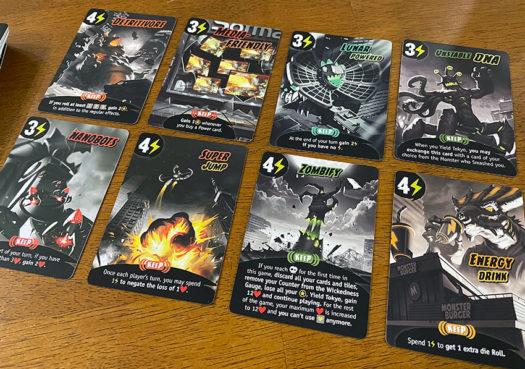
We also like that the energy cubes aren’t cubes in this version. Instead, they’re now lightning bolts that match both the back of the Power cards as well as the symbol showing their cost. It’s all nicely consistent.
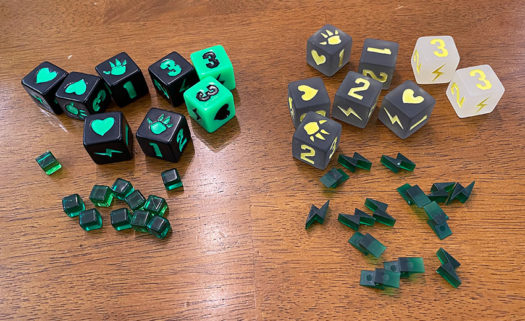
Which version of King of Tokyo wins?
If you’re a fan of King of Tokyo, we’d guess you’re totally tempted to get this new collector’s edition. And we’re not going to stop you. Because we love it too!
In our family, I imagine we’re going to grab King of Tokyo: Dark Edition almost every time we want to have a dice-rolling, king of the hill, slugfest. We love the art style and love the addition of Wickedness points for more interesting choices and extra powers.
However, we’re not quite ready to ditch our original 2011 copy either. That’s partly because we own the Power Up expansion and find fun in playing with those monster evolutions as well. We also have King of New York and will still pull that out from time to time for a slight twist on the theme.
For those that haven’t played King of Tokyo or don’t have a copy of the game, we’d recommend jumping straight to the Dark Edition of the game.
Best of luck in your monster battles!
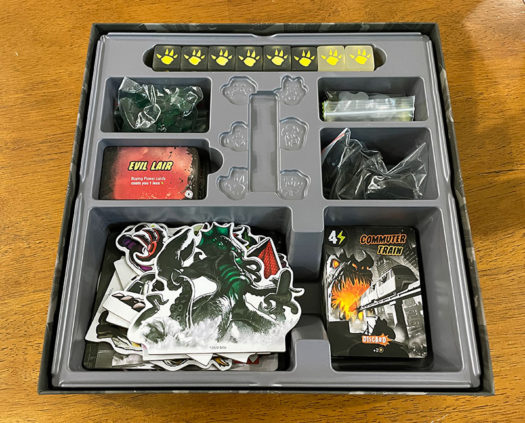
We’d like to thank iello for a review copy of King of Tokyo: Dark Edition.



